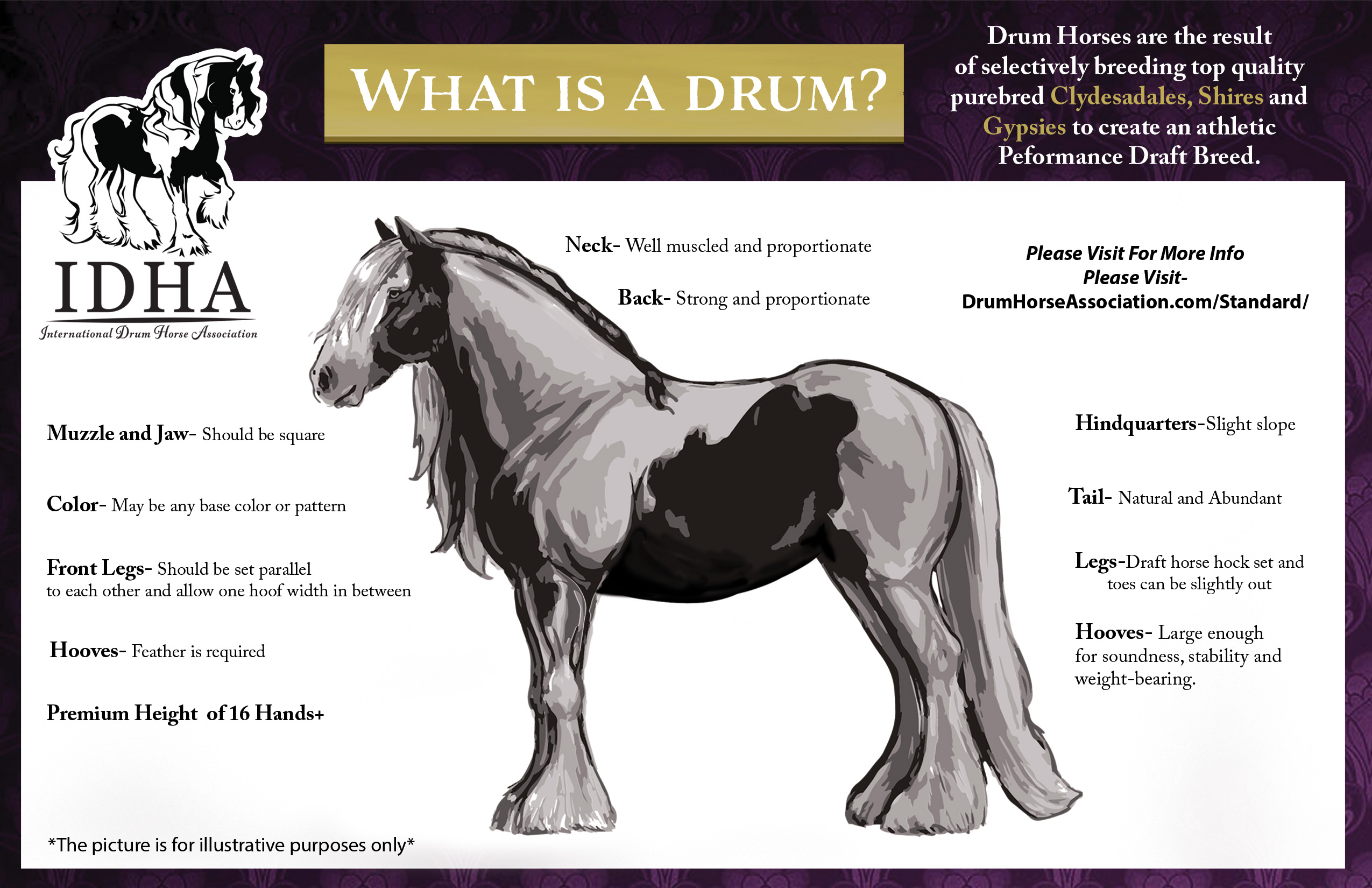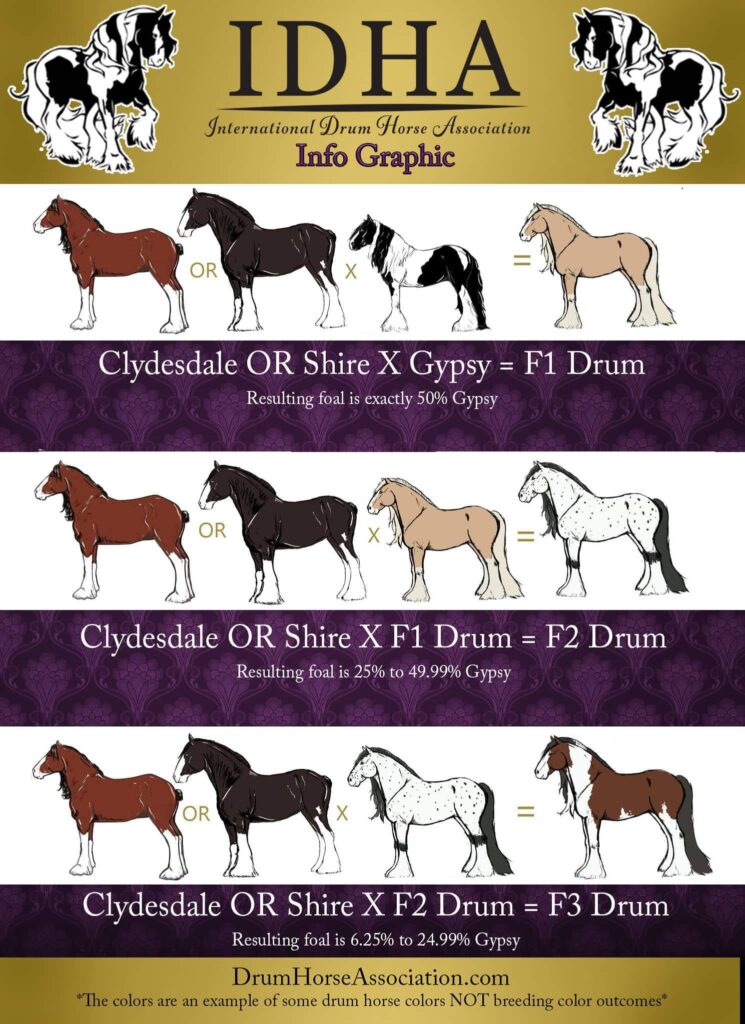The Drum Horse is a combination of the following breeds: Gypsy Horse and Shire and/ or Clydesdale, where the Gypsy Horse does not exceed 50% of the total make-up or fall below 6.25%. Horses with greater than 50% Gypsy or less than 6.25% Gypsy will be placed in the Foundation Drum Book. The IDHA maintains three separate Stud Books: Foundation Horse Book: A purebred (registered) Clydesdale, Shire, or Gypsy Horse or a cross of a (registered) Clydesdale and (registered) Shire. Foundation Drum Horse Book: A horse that contains Clydesdale and/or Shire and where the Gypsy percentage is greater than 50% or less than 6.25%. Drum Horse Book: A horse that contains Clydesdale and/or Shire with a minimum of 6.25% Gypsy, but not to exceed 50% Gypsy. Classifications: F1 Drum Horse: A horse that is Clydesdale and/or Shire and exactly 50% Gypsy The purpose of the Drum Horse as a breed is to develop a new heavy horse breed that utilizes the best attributes of the Shire, Clydesdale, and Gypsy breeds, while focusing on breeding for athleticism, agility, and performance ability for all ridden disciplines. The inspiration for the Drum Horse is the working horses still found carrying riders and heavy kettledrums in the Queen of England’s cavalry. General Appearance: The overall impression of the Drum Horse should be one of an elegant heavy horse of great strength and agility. The Drum Horse is a heavy riding horse, and should therefore display the athleticism to allow for competitiveness in all ridden and driven disciplines. The Drum should be a large, well-muscled horse of medium to heavy weight, with good quality bone, an athletic body, a kind expression, and abundant hair (including heavy feather on the legs). Size: The Drum Horse should be a large, athletic animal capable of excelling in a variety of equine disciplines. To achieve this goal members are encouraged to select breeding stock of a size that will help ensure their Drum Horses will reach the desired mature height of 16 hands or taller. Disposition: The Drum Horse should display good character and be a willing and sensible partner. Color: Drum Horses may have any base color, and may be solid or colored. There is no preference given to colored horses over solid colored horses. Hair: Mane and tail should be natural and abundant. Feather is a required characteristic of a Drum Horse. Feathering should preferably begin above the fetlock joints, and start at the back of the knee and hocks, as well as run down the leg to cover the entire hoof. Feather should be silky and soft, and may be either straight or curly. Trimming of the mane, tail, and feather is not desired, unless required for a discipline in which the horse in question competes. Clipping or trimming of bridle paths, belly hair, jaw and ear hair is permissible and up to each individual owner/breeder. Docking of tails is not permitted*. (*Docking rule applies ONLY to foals born in the United States and horses already registered with the IDHA.) Movement: The ideal Drum Horse should move naturally, with forward impulsion and presence, during all three gaits: Walk: Horse should walk flat with a straight four-beat, ground-covering gait. Stride should be consistent and balanced. Trot: The trot should be coordinated, straight, and balanced. There should be two distinct beats in which front and hind legs are moving diagonally. Action at the knees may be snappy and naturally animated, or regular and extended. The Drum Horse should use his hind end well, and hocks should be powerful and work close together. Canter: The canter should be a fluid three-beat gait, exhibiting balance, cadence and strong use of the horse’s hindquarters. Head: The head should be attractive and in proportion to the body. The forehead and poll should be wide, but not so wide as to lose the appearance of overall proportion to the length of the head. The muzzle and jaw should be square, and tie in cleanly to the rest of the head. The upper and lower lip should meet, and the horse’s bite should be even. The ears should be attractive and in proportion with the head, and carried alertly. The eyes should appear expressive and kind, and should be an appropriate size in relation to the horse’s head. Eyes may be any color. Both convex and straight profiles are acceptable, given they are appropriate for the horse’s body type. Neck: The neck should be long, well muscled, and in proportion to the horse’s frame. Throat latch should be clean, allowing for good flexion at the poll. The length of the neck should be well proportioned in comparison to the length of the back, and should tie in smoothly at the shoulder and withers. Stallions may exhibit a masculine crest in proper relationship to the size and thickness of neck. Mares should have a more refined, feminine head and neck. Chest: The chest should be deep and as broad as the shoulders, balanced in appearance compared to the rest of the body. Shoulders: The shoulders should be set far enough apart to allow for each front leg to be centered under each point of the shoulder. Shoulders should be level and in balance with each other. The slope of the shoulder and the slope of the pastern should ideally be the same angle (as close to a 45-50 degree angle as possible). Withers: Withers should be average in height (not too high or low) and well-defined, with a generous layer of muscle. They should be sloping, and preferably lie further back than the elbow, to allow for greater scope of motion in the forelimbs. Back, Loins, and Croup: The back should be strong and in proportion with the horse’s overall frame and build. The back should be half the length of the underline. The back should tie in well with the loins, which should be wide and strong on the mature horse. The loins should lead fluently into the croup, which should have a slight downward slope. The croup should not be short or steep/pointed, nor overly round. Barrel: The barrel (or the body) should be well-rounded with long, well set ribs. It should be broad and deep, giving a round appearance. Front Legs: When viewed from the front, front legs should be set parallel to each other and far enough apart to allow one hoof width in between. When viewed from the side, legs should be straight to the fetlock joint. The knee should be slightly wider than the leg itself, and “flat,” as opposed to “round,” in appearance. The cannon bone should be half of the length of the forearm. Pasterns should ideally be the same angle as the shoulders. Back Legs: When viewed from behind, the back legs should display a “draft horse hock set,” where the toes can be slightly turned out, but should not be cow hocked or sickle hocked when viewed from the side. When the horse is standing square and viewed from the side, the hind legs should be set directly under the hindquarters, with the point of the hock directly beneath the point of the buttock. The hock should be flat in appearance with tendons clearly defined, and ideally a little higher than the front knee. The cannon bone in the rear leg should be slightly longer than in the front legs. Hooves: Hooves should be large enough for soundness, stability and weight-bearing, but not exaggerated in proportion to the horse’s build. Heels should be open, and hooves should be well shaped to provide long years of sound use. The Drum Horse must be a proven combination of any of the following breeds: Shire, Clydesdale, and Gypsy Horse, where no single breed listed above exceeds 87.5% of the total make-up and the percentage of Gypsy Horse blood does not fall below 6.25% . Therefore the breeder must consider the bloodlines of any mare used to create Drum Horses and breed her to a stallion that will maintain the proper combination of breeds in the correct percentages. [Note: starting in 2015, the % of Gypsy breeding cannot exceed 50%. Horses foaled after 2015 with more than 50% Gypsy breeding will be placed in the Foundation Book]. Effective for foals born in 1999 and later, all mares must have blood type/DNA information on file with the registry prior to registration of their foals. All Foundation Horses (Clydesdales, Shires, and Gypsies) must be registered within their own breed registry or be passported within that breed. As always, the IDHA will dual register Foundation Stock for DNA verification. There are two instances where non-registered stock is accepted: 1) a Shire x Clydesdale where there is no registry available (as is the case in the USA). However, the parents MUST be registered and copies of registration papers submitted. 2) The Shire or Clydesdale in question was at one point registered, but the papers were lost. It is the owner’s responsibility to prove prior registration to the satisfaction of the Board of Directors. The IDHA provides due diligence, including DNA testing when accepting a horse for registration in the IDHA books. We strive very hard to ensure that each horse qualifies for the book that it is registered in, and that it meets the rules and breed standards of the IDHA. Because this is a new breed and many of the horses in the pedigrees of the IDHA registered horses are not yet in the DNA database we cannot be absolute when stating a pedigree on a registration certificate. Therefore the IDHA cannot accept liability for any parentage, pedigree, or other registration information that it cannot verify.

F2 Drum Horse: A horse that is Clydesdale and/or Shire and 25% to 49.99% Gypsy
F3 Drum Horse: A horse that is Clydesdale and/or Shire and 6.25% to 24.99% Gypsy.
Premium Drum: This horse can be an F1, F2, or F3 Drum Horse. It is a horse that by his/her 7th birthday is 16hh or greater and is height certified by a vet or an IDHA representative.PURPOSE OF THE BREED
BREED STANDARD
HOOVES AND LEGS
BREEDING FOR A DRUM HORSE
FOUNDATION

